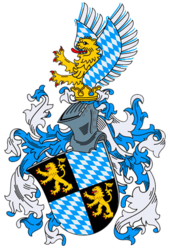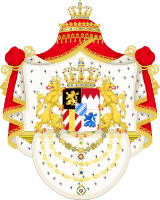German noble family
Coat of arms (13th to 14th century). The white-and-blue lozenges came to the family when Otto II Wittelsbach, Duke of Bavaria acquired the county of Bogen in 1240 Coat of arms (15th century), the Wittelsbach (Bogen) lozenges quartered with the lion of the Palatinate. The House of Wittelsbach (German : Haus Wittelsbach ) is a former Bavarian dynasty , with branches that have ruled over territories including the Electorate of Bavaria , the Electoral Palatinate , the Electorate of Cologne , Holland , Zeeland , Sweden (with Swedish-ruled Finland ), Denmark, Norway, Hungary , Bohemia , and Greece . Their ancestral lands of Bavaria and the Palatinate were prince-electorates , and the family had three of its members elected emperors and kings of the Holy Roman Empire . They ruled over the Kingdom of Bavaria which was created in 1805 and continued to exist until 1918.
The House of Windsor , the reigning royal house of the British monarchy , are descendants of Sophia of Hanover (1630–1714), a Wittelsbach Princess of the Palatinate by birth and Electress of Hanover by marriage, who had inherited the succession rights of the House of Stuart and passed them on to the House of Hanover .[ 1] [ 2]



